Study on Compression Deformation and Damage Characteristics of Pine Needle Fiber-Reinforced Concrete Using DIC
Abstract
:1. Introduction
2. Experimental Section
2.1. Test Materials and Specimens
2.1.1. Materials and Mix Design
2.1.2. Specimen Design
2.2. Test Materials and Specimens
2.2.1. Digital Image Correlation (DIC)
2.2.2. Compressive Strength Test of PNFRC
3. Results and Analysis
3.1. Cracking Mode and Fractal Characteristics of PNFRC Samples
3.2. Micro-Analysis of SEM
3.3. The Compressive Damage Process Analysis
3.4. Statistical Analysis of PNFRC Damage
4. Conclusions
- (1)
- The fractal dimension of fiber-reinforced concrete treated with tap water soaking, boiling water, and an alkali solution is consistent with the macroscopic results of damaged morphology. At the same time, it is proved that pine needle fiber can promote the deformation and damage of concrete from the micro point of view. The SEM results show that the surface of the alkali-treated fiber is wrapped with cement mortar, which produces cracks after the concrete is damaged.
- (2)
- At 50% of the peak load, the strain concentration zone of the 0.5–1.5% PNFRC appears, and the strain concentration zone develops to the maximum at 90% of the peak load. The “X” type strain concentration zone of other samples is irregular at the peak load, compared with ordinary concrete and 2% pine needle fiber concrete.
- (3)
- Adding natural fiber can change the damage growth rate of concrete and make the damage curve grow evenly and slowly. The samples A30C10 show the best deformation and damage performance. The damage degree of the samples treated with boiling water is greater than that of the samples treated with dilute alkali in the elastic deformation stage.
- (4)
- The damage factor Dfa could accurately reflect the compression damage of PNFRC. In the process of compression deformation, the defined damage factor can characterize the details of the damage and deformation of each specimen.
Author Contributions
Funding
Institutional Review Board Statement
Informed Consent Statement
Data Availability Statement
Conflicts of Interest
References
- Tioua, T.; Kriker, A.; Barluenga, G.; Palomar, I. Influence of date palm fiber and shrinkage reducing admixture on self-compacting concrete performance at early age in hot-dry environment. Constr. Build. Mater. 2017, 154, 721–733. [Google Scholar] [CrossRef]
- Rahim, M.; Douzane, O.; Le, A.T.; Langlet, T. Effect of moisture and temperature on thermal properties of three bio-based materials. Constr. Build. Mater. 2016, 111, 119–127. [Google Scholar] [CrossRef]
- Boumhaout, M.; Boukhattem, L.; Hamdi, H.; Benhamou, B.; Nouh, F.A. Thermomechanical characterization of a bio-composite building material: Mortar reinforced with date palm fibres mesh. Constr. Build. Mater. 2017, 135, 241–250. [Google Scholar] [CrossRef]
- Saravanan, N.; Buvaneshwari, M. Experimental Investigation on Behaviour of Natural Fibre Concrete (Sisal Fibre). Cellulose 2018, 54, 66. [Google Scholar]
- Chandel, A.; Shah, T.; Shah, T.; Varde, D. A comparative strength study of coir fiber-reinforced concrete (CFRC) over plain cement concrete (PCC). J. Mech. Civ. Eng. IOSR-JMCE 2016, 13, 95–97. [Google Scholar]
- Andiç-Çakir, Ö.; Sarikanat, M.; Tüfekçi, H.B.; Demirci, C.; Erdoğan, Ü.H. Physical and mechanical properties of randomly oriented coir fiber–cementitious composites. Compos. Part B 2014, 61, 49–54. [Google Scholar] [CrossRef]
- Chikhi, M.; Agoudjil, B.; Boudenne, A.; Gherabli, A. Experimental investigation of new biocomposite with low cost for thermal insulation. Energy Build. 2013, 66, 267–273. [Google Scholar] [CrossRef]
- Bui, H.; Sebaibi, N.; Boutouil, M.; Levacher, D. Determination and review of physical and mechanical properties of raw and treated coconut fibers for their recycling in construction materials. Fibers 2020, 8, 37. [Google Scholar] [CrossRef]
- de Azevedo, A.R.; Marvila, M.T.; Tayeh, B.A.; Cecchi‘n, D.; Pereira, A.C.; Monteiro, S.N. Technological performance of açaí natural fiber-reinforced cement-based mortars. J. Build. Eng. 2020, 33, 101675. [Google Scholar] [CrossRef]
- Petrounias, P.; Rogkala, A.; Giannakopoulou, P.P.; Lampropoulou, P.; Golfinopoulos, A. An innovative experimental petrographic study of concrete produced by animal bones and human hair fibers. Sustainability 2021, 13, 8107. [Google Scholar] [CrossRef]
- Oladele, I.O.; Omotoyinbo, J.A.; Adewara, J.O.T. Investigating the effect of chemical treatment on the constituents and tensile properties of sisal fiber. J. Miner. Mater. Charact. Eng. 2010, 9, 569. [Google Scholar]
- Al-Oraimi, S.K.; Seibi, A.C. Mechanical characterisation and impact behaviour of concrete reinforced with natural fibres. Compos. Struct. 1995, 32, 165–171. [Google Scholar] [CrossRef]
- Islam, S.M.; Hussain, R.R.; Morshed, M.A.Z. Fibre-reinforced concrete incorporating locally available natural fibres in normal-and high-strength concrete and a performance analysis with steel fiber-reinforced composite concrete. J. Compos. Mater. 2012, 46, 111–122. [Google Scholar] [CrossRef]
- Claramunt, J.; Ardanuy, M.; García-Hortal, J.A.; Tolêdo Filho, R.D. The hornification of vegetable fibres to improve the durability of cement mortar composites. Cem. Concr. Compos. 2011, 33, 586–595. [Google Scholar] [CrossRef]
- Le Troëdec, M.; Dalmay, P.; Patapy, C.; Peyratout, C.; Smith, A.; Chotard, T. Mechanical properties of hemp-lime reinforced mortars: Influence of the chemical treatment of fibres. J. Compos. Mater. 2011, 45, 2347–2357. [Google Scholar] [CrossRef]
- Raghavendra Rao, H.; Varada Rajulu, A.; Ramachandra Reddy, G.; Hemachandra Reddy, K. Flexural and compressive properties of bamboo and glass fiber-reinforced epoxy hybrid composites. J. Reinf. Plast. Compos. 2010, 29, 1446–1450. [Google Scholar] [CrossRef]
- Zhou, X.; Saini, H.; Kastiukas, G. Engineering properties of treated natural hemp fiber-reinforced concrete. Front. Built Environ. 2017, 3, 33. [Google Scholar] [CrossRef] [Green Version]
- Wei, J.; Meyer, C. Improving degradation resistance of sisal fiber in concrete through fiber surface treatment. Appl. Surf. Sci. 2014, 289, 511–523. [Google Scholar] [CrossRef]
- Long, W.; Wang, Y. Effect of pine needle fiber reinforcement on the mechanical properties of concrete. Constr. Build. Mater. 2021, 278, 122333. [Google Scholar] [CrossRef]
- Wang, Y.; Long, W. Complete stress–strain curves for pine needle fiber-reinforced concrete under compression—sciencedirect. Constr. Build. Mater. 2021, 302, 124134. [Google Scholar] [CrossRef]
- Del Enrique, R.; Tom, A.; Richard, H. Digital image correlation (dic) for measurement of strains and displacements in coarse, low volume-fraction frp composites used in civil infrastructure. Compos. Struct. 2019, 212, 43–47. [Google Scholar]
- Guo, Q.; Wang, H.; Gao, Y.; Jiao, Y.; Liu, F.; Dong, Z. Investigation of the low-temperature properties and cracking resistance of fiber-reinforced asphalt concrete using the dic technique. Eng. Fract. Mech. 2020, 229, 106951. [Google Scholar] [CrossRef]
- Niu, Y.; Huang, H.; Zhang, J.; Jin, W.; Yu, Q. Development of the strain field along the crack in ultra-high-performance fiber-reinforced concrete (uhpfrc) under bending by digital image correlation technique. Cem. Concr. Res. 2019, 125, 105821. [Google Scholar] [CrossRef]
- Shen, X.; Brühwiler, E. Influence of local fiber distribution on tensile behavior of strain hardening uhpfrc using ndt and dic. Cem. Concr. Res. 2020, 132, 106042. [Google Scholar] [CrossRef]
- Donnini, J.; Lancioni, G.; Chiappini, G.; Corinaldesi, V. Uniaxial tensile behavior of ultra-high performance fiber-reinforced concrete (uhpfrc): Experiments and modeling. Compos. Struct. 2020, 258, 113433. [Google Scholar] [CrossRef]
- D’Anna, J.; Amato, G.; Chen, J.F.; Minafò, G.; La Mendola, L. Experimental application of digital image correlation for the tensile characterization of basalt FRCM composites. Constr. Build. Mater. 2021, 271, 121770. [Google Scholar] [CrossRef]
- Hu, J.H.; Sun, M.Q.; Li, J.; Wei, Y.P.; Chen, J.Z. Tensile characteristics of strain-hardening cement-based composites with different curing ages. Constr. Build. Mater. 2019, 221, 709–719. [Google Scholar] [CrossRef]
- Mobasher, B.; Li, A.; Yao, Y.; Arora, A.; Neithalath, N. Characterization of toughening mechanisms in uhpc through image correlation and inverse analysis of flexural results. Cem. Concr. Compos. 2021, 122, 104157. [Google Scholar] [CrossRef]
- Corr, D.; Accardi, M.; Graham-Brady, L.; Shah, S. Digital image correlation analysis of interfacial debonding properties and fracture behavior in concrete. Eng. Fract. Mech. 2006, 74, 109–121. [Google Scholar] [CrossRef]
- Domenico D., D.; Quattrocchi, A.; Alizzio, D.; Montanini, R.; Urso, S.; Ricciardi, G.; Recupero, A. Experimental Characterization of the FRCM-Concrete Interface Bond Behavior Assisted by Digital Image Correlation. Sensors 2021, 21, 1154. [Google Scholar] [CrossRef]
- Golewski, G.L. Validation of the favorable quantity of fly ash in concrete and analysis of crack propagation and its length-using the crack tip tracking (ctt) method—In the fracture toughness examinations under mode Ⅱ, through digital image correlation. Constr. Build. Mater. 2021, 296, 122362. [Google Scholar] [CrossRef]
- Al-Lami, K.; Colombi, P.; D’Antino, T. Influence of hygrothermal ageing on the fracture energy and mechanical properties of CFRP-concrete joints and their components. Compos. Struct. 2020, 238, 111947. [Google Scholar] [CrossRef]
- Francioso, V.; Moro, C.; Castillo, A.; Velay-Lizancos, M. Effect of elevated temperature on flexural behavior and fibers-matrix bonding of recycled pp fiber-reinforced cementitious composite—sciencedirect. Constr. Build. Mater. 2020, 269, 121243. [Google Scholar] [CrossRef]
- Del Zoppo, M.; Menna, C.; Di Ludovico, M.; Asprone, D.; Prota, A. Opportunities of light jacketing with fiber-reinforced cementitious composites for seismic retrofitting of existing rc columns. Compos. Struct. 2021, 263, 113717. [Google Scholar] [CrossRef]
- Zhao, Y.R.; Wang, L.; Lei, Z.K.; Han, X.F.; Shi, J.N. Study on bending damage and failure of basalt fiber-reinforced concrete under freeze–thaw cycles. Constr. Build. Mater. 2018, 163, 460–470. [Google Scholar] [CrossRef]
- Liu, B.; Guo, J.H.; Wen, X.Y.; Zhou, J.K.; Deng, Z.H. Study on flexural behavior of carbon fibers reinforced coral concrete using digital image correlation. Constr. Build. Mater. 2020, 242, 117968. [Google Scholar] [CrossRef]
- Ma, S.P.; Zhou, H. Evolution characteristics of strain field on specimen surface during rock failure. J. Rock Mech. Eng. 2008, 27, 1667–1673. [Google Scholar]
- Zhang, H.; Huang, G.Y.; Song, H.P.; King, Y.L. Experimental characterization of strain localization in rock. Geophys. J. Int. 2013, 194, 1554–1558. [Google Scholar] [CrossRef] [Green Version]
- GB5749-2006; Code for Drinking Water. Chinese Academy of Building Sciences: Beijing, China, 2007.
- GB/T 50081-2019; Standard for Test Methods of Concrete Physical and Mechanical Properties. Chinese Academy of Building Sciences: Beijing, China, 2007.

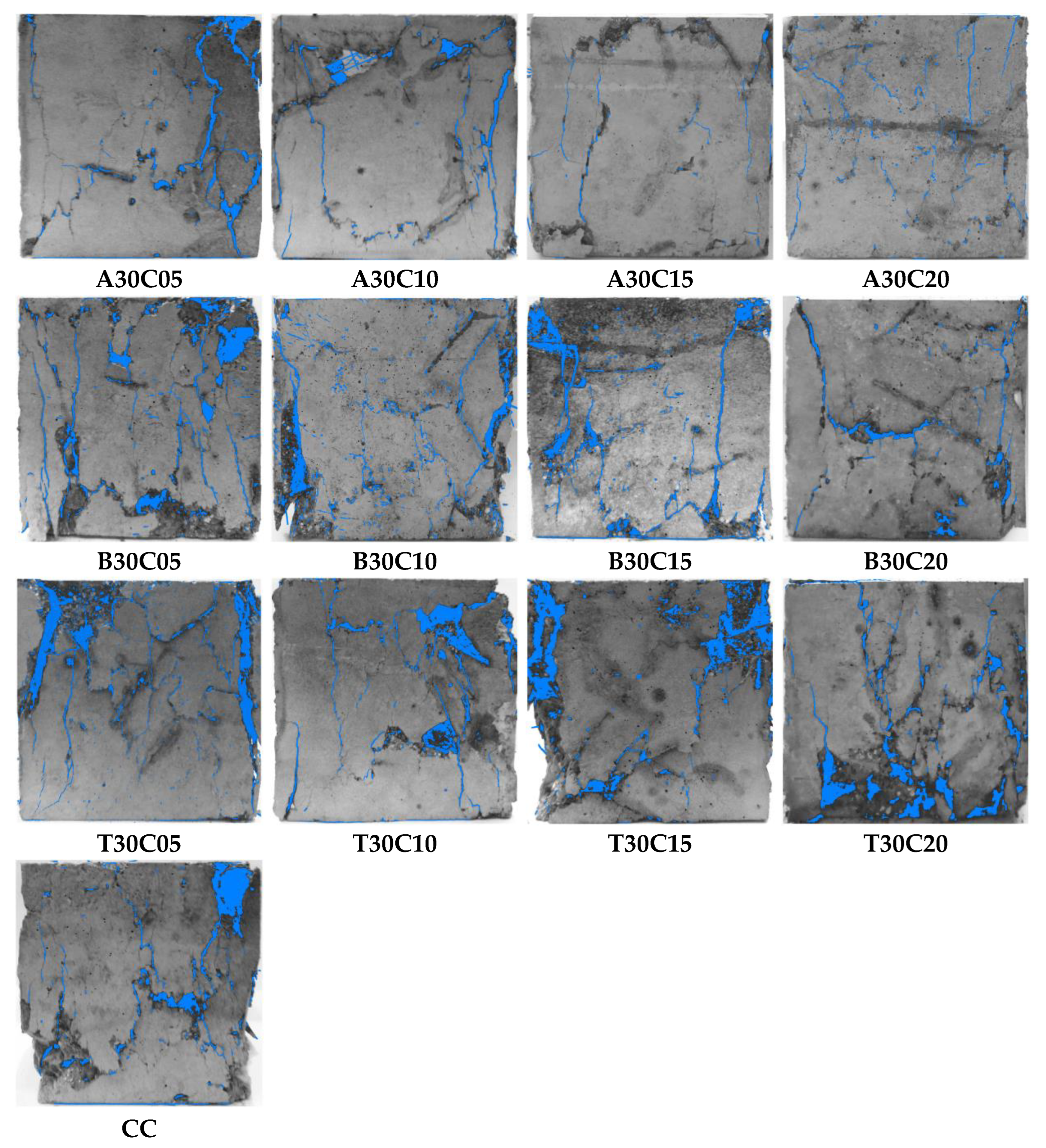
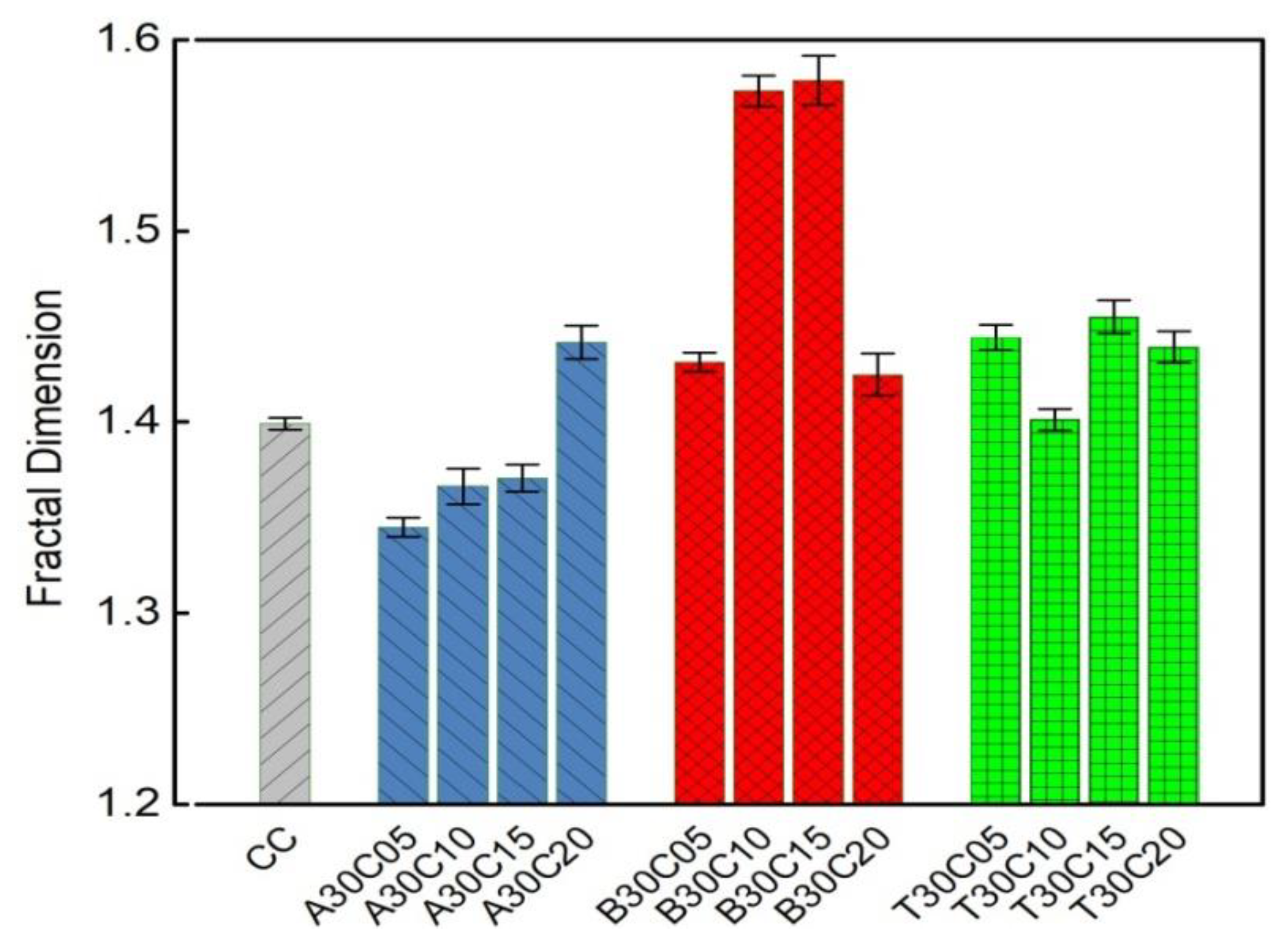


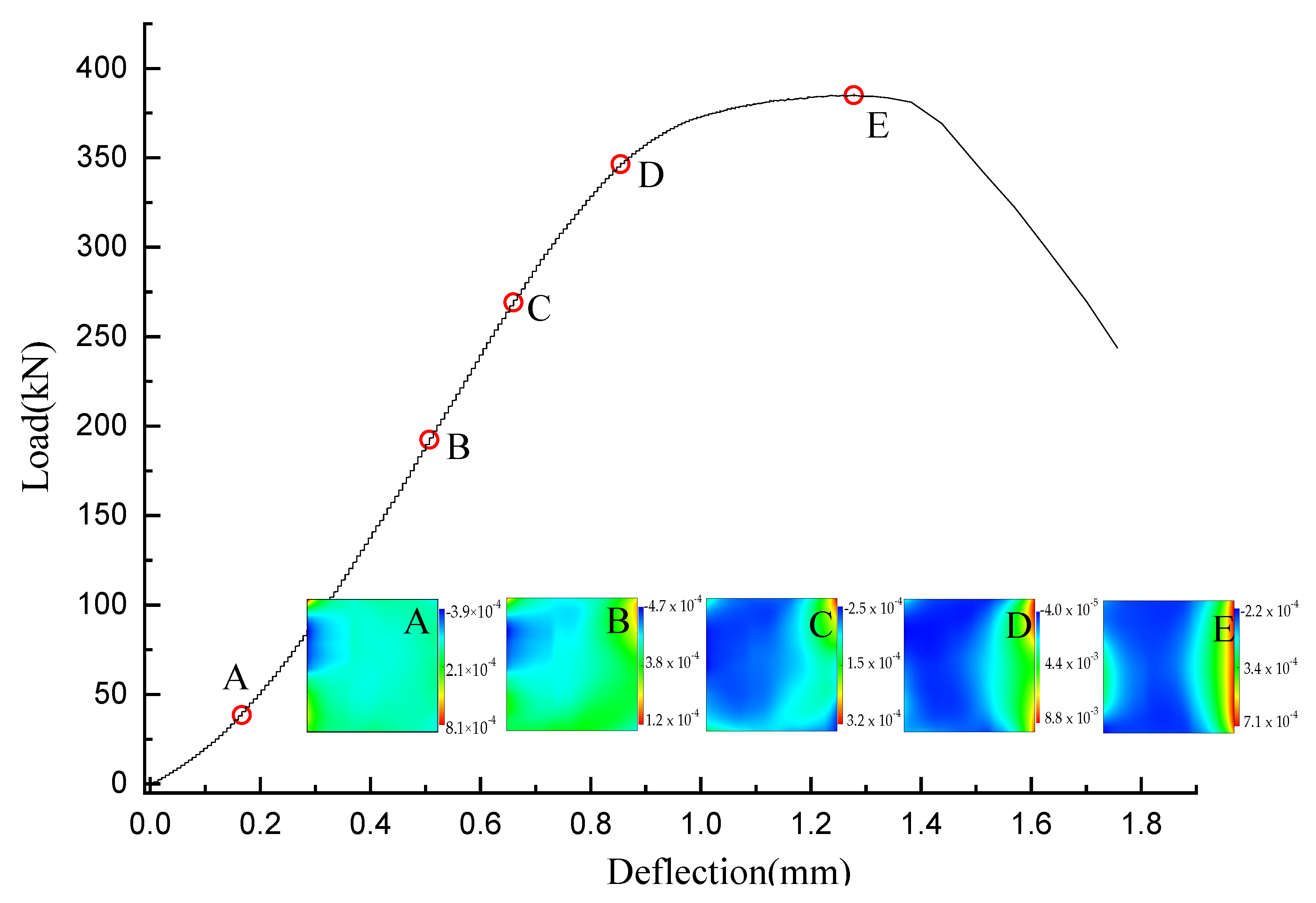
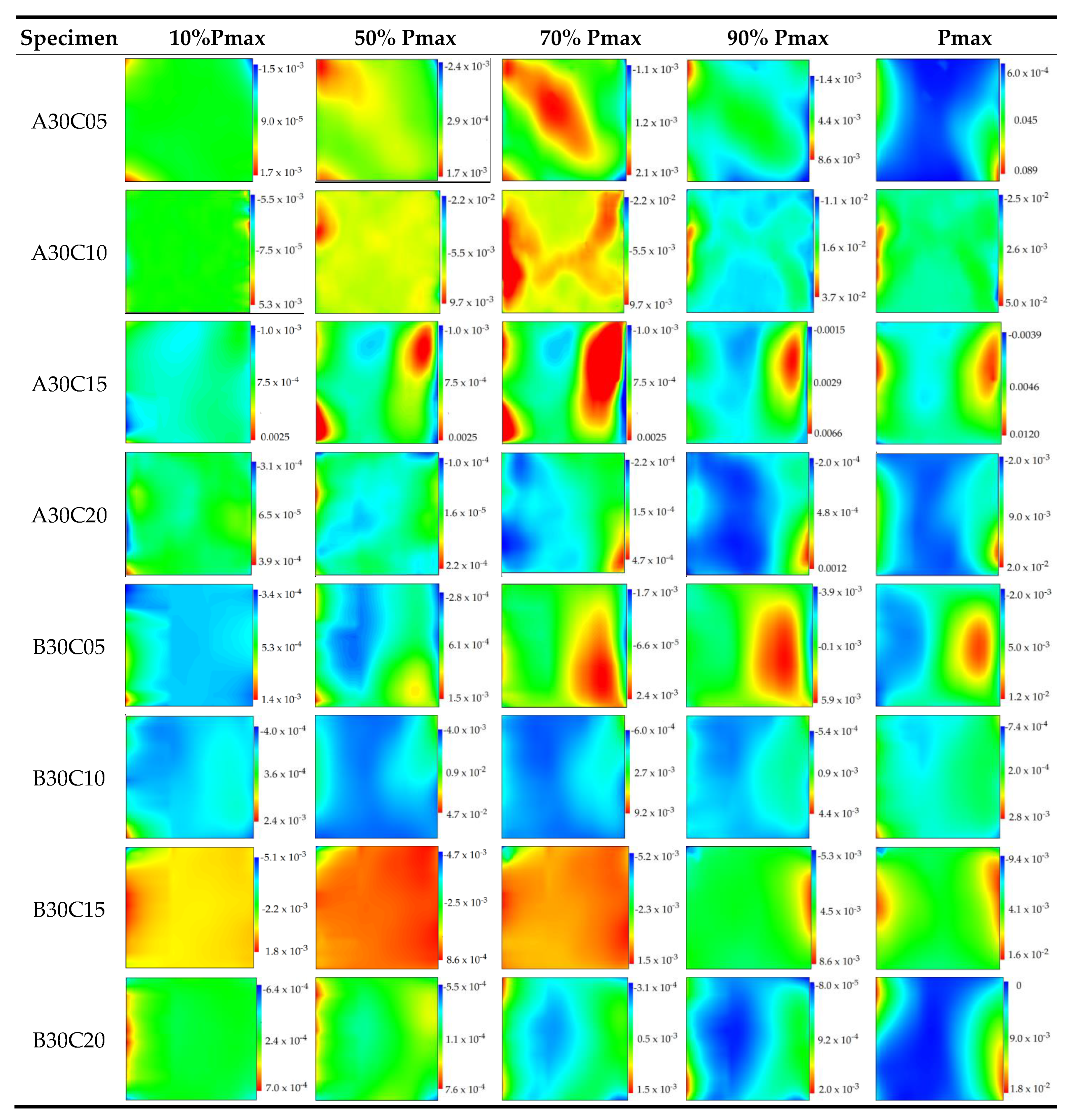
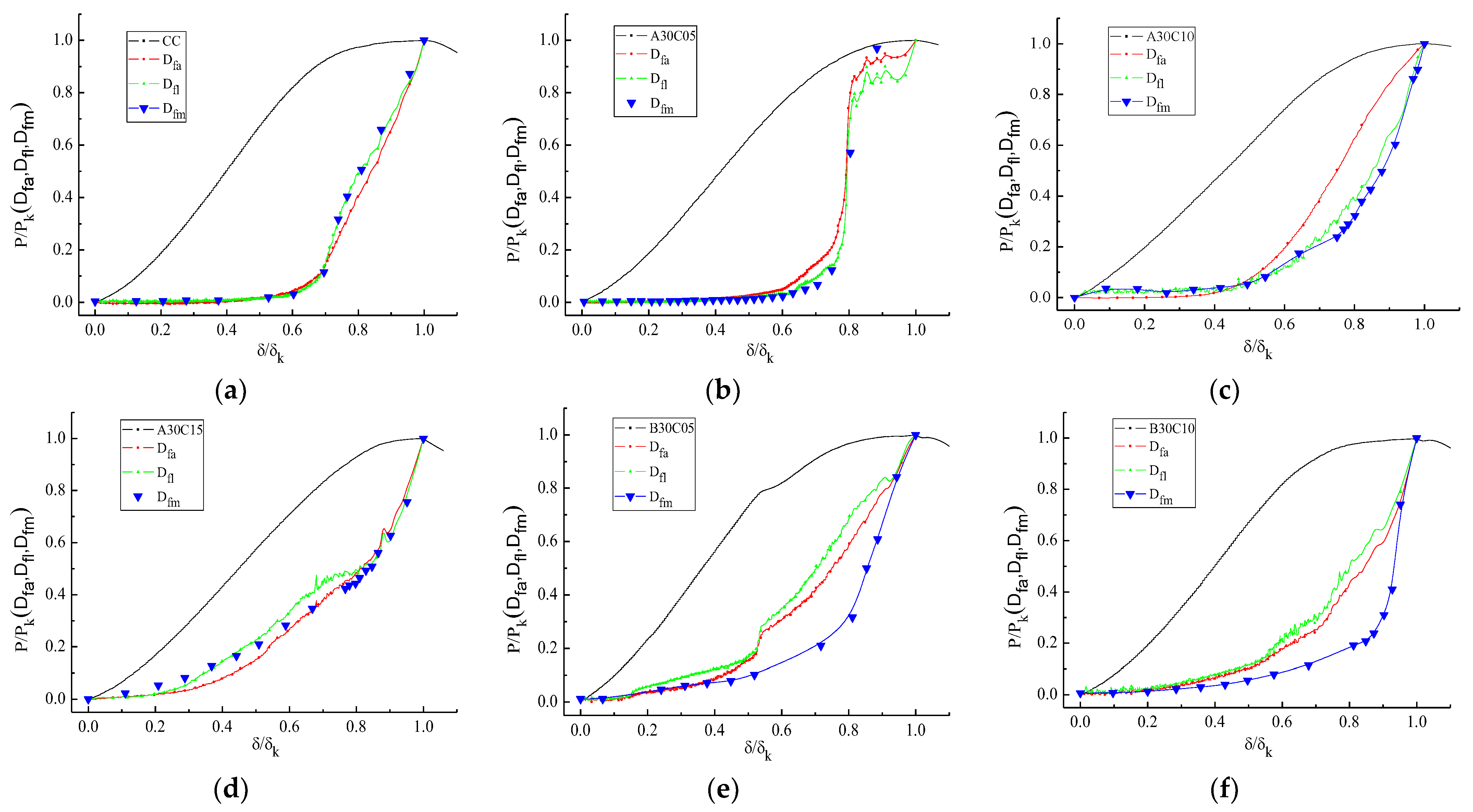
| W/B | Sample Size | Fiber Pretreated Method | Fiber Volume | ||||
|---|---|---|---|---|---|---|---|
| 0% | 0.5% | 1.0% | 1.5% | 2.0% | |||
| 0.49 | 100 × 100 × 100 mm3 | Tap water soaking | CC | T30C05 | T30C10 | T30C15 | T30C20 |
| Boiling water | B30C05 | B30C10 | B30C15 | B30C20 | |||
| Alkalinized solution | A30C05 | A30C10 | A30C15 | A30C20 | |||
Publisher’s Note: MDPI stays neutral with regard to jurisdictional claims in published maps and institutional affiliations. |
© 2022 by the authors. Licensee MDPI, Basel, Switzerland. This article is an open access article distributed under the terms and conditions of the Creative Commons Attribution (CC BY) license (https://creativecommons.org/licenses/by/4.0/).
Share and Cite
Wang, Y.; Gao, S.; Li, W. Study on Compression Deformation and Damage Characteristics of Pine Needle Fiber-Reinforced Concrete Using DIC. Materials 2022, 15, 1654. https://doi.org/10.3390/ma15051654
Wang Y, Gao S, Li W. Study on Compression Deformation and Damage Characteristics of Pine Needle Fiber-Reinforced Concrete Using DIC. Materials. 2022; 15(5):1654. https://doi.org/10.3390/ma15051654
Chicago/Turabian StyleWang, Yonggang, Shan Gao, and Wei Li. 2022. "Study on Compression Deformation and Damage Characteristics of Pine Needle Fiber-Reinforced Concrete Using DIC" Materials 15, no. 5: 1654. https://doi.org/10.3390/ma15051654
APA StyleWang, Y., Gao, S., & Li, W. (2022). Study on Compression Deformation and Damage Characteristics of Pine Needle Fiber-Reinforced Concrete Using DIC. Materials, 15(5), 1654. https://doi.org/10.3390/ma15051654






